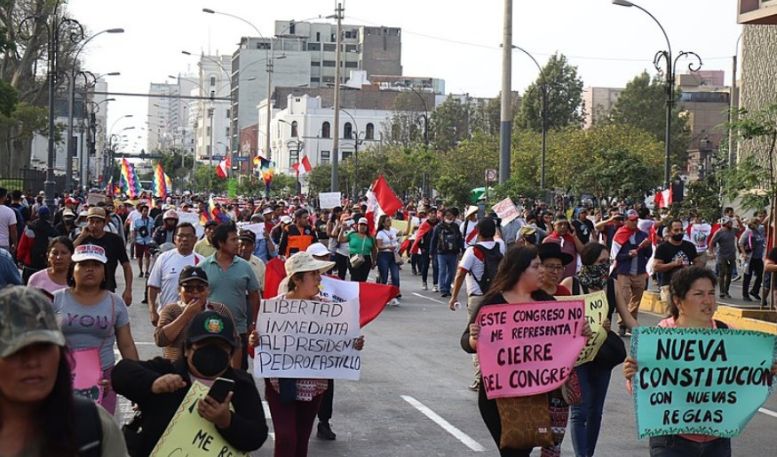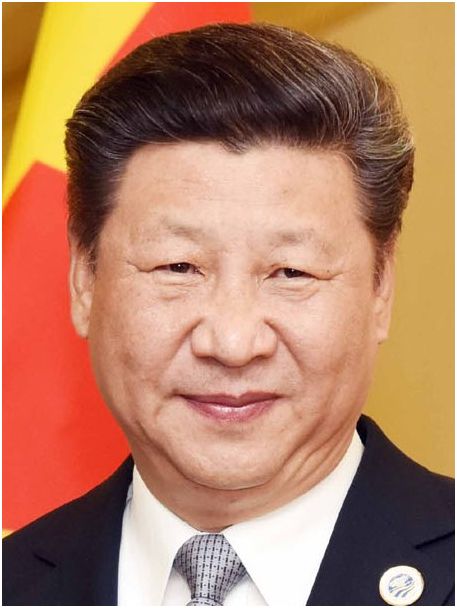Report of the discussion on World Perspectives at ISA’s 2023 World Congress
Climate disasters, raging inflation and the threat of a world recession. A brutal war in Ukraine and rising global tensions. Three years of COVID with health systems teetering on the breaking points. Political polarization and unstable governments. The ruling class looks to the future filled with doubt and a lack of confidence. Talk of the “Age of Disorder” and “polycrisis” abound. Strikes, rebellions and mass protests. This is planet Earth at the start of 2023.
International Socialist Alternative’s recent World Congress discussed these themes from a Marxist perspective. While recognizing the grim situation that capitalism has created, a Marxist analysis explains the causes of this era of crises. Marxism seeks to make sense of current trends, point to future developments and outline how the working class, the vast majority of humanity around the world, can overcome the current multiple disasters.
Climate Disaster
Looming over everything are the mounting environmental disasters as capitalism ravages the planet’s ecology and natural systems. As well as climate change, plastic pollution is everywhere, biodiversity is severely threatened and species are disappearing at an alarming rate. These are some of many wounds that capitalism has inflicted as it robs nature to boost profits.
To many, especially young people, it feels that humanity is facing a stark choice about survival. Every month brings new disasters of worsening floods, heatwaves, droughts, fires and powerful storms.
The annual world conferences of COPs (Conference of the Parties) produce glowing reports but no change. CO2 releases into the atmosphere continue to increase. At COP27, held under the Egyptian dictatorship, there were over one thousand lobbyists from the United Arab Emirates (UAE), more than any other country. UAE is a major exporter of oil and gas and plans to double its oil output by 2027. UAE will host COP28 with Sultan Al Jaber, head of its oil company, the conference’s president, thus dropping any pretense that these events are about finding solutions to the climate crisis. Humanity can expect no answer to climate change for this process. After three decades it is a failure. As Greta Thunberg stated, it only produces, “Blah, blah, blah.”
Much has been made of so-called clean technology and carbon offsetting to tackle the climate disaster. A recent report shows that most offsetting is worthless. Huge sums of money are being poured into carbon capture, the idea that industry can continue to burn carbon but somehow capture the exhaust gases. Again, this is a huge scam that is very expensive and does not work. Big oil and the banks that support it are continuing to expand fossil fuel production, and con humanity that somehow, magically, the carbon will not add to climate change.
Most of the tools for a transition to clean energy — wind, water, solar and geothermal — already exist. That is a message of hope that the environmental movement needs to heed. The barrier to the shift is not technical. It is capitalism, based on private ownership of land and resources and production for profit, that stands in the way.
There is a wing of the environmental movement desperate to avoid struggle, and certainly avoid any critique of capitalism. They will grasp at any straws, such as carbon capture and nuclear power. The German Greens demonstrated this last year when they agreed to the major expansion of the coalmine at Luetzerath, and supported increasing Germany’s arm expenditure by €100 billion — they provide no answer to the ecological disasters. Over time, the inevitable failures of “green capitalism” will push the movement to a deeper analysis of the connection between capitalism and the ecological crises.
Already a wing is recognizing the need to combine the struggle on climate with other working-class struggles including the fight for secure jobs and homes. They are linking with workers, many facing an insecure future, to fight for good jobs in the transition to clean energy and restoring the health of the environment. This is at the core of ISA’s environmental campaigning and activity.
War: “Hot” and “Cold”
The brutal war in Ukraine has reawoken fear of nuclear conflict (see more of our analysis on the war in Ukraine). The Putin regime is inflicting enormous suffering on Ukrainian workers. The brutality of Russia’s regime is also shown in the callous disregard for the lives of its own troops sent in mass waves to be slaughtered in battles described as “meat-grinders.”
While the Ukrainian people are clearly fighting for their homes and lives, the Zelensky government continues to privatize sectors of the economy vital to the war effort and attack the few democratic rights that exist in the country.
The US and NATO are not sending billions of dollars of arms out of love for Ukrainians, they are using the suffering of the Ukrainian people to test the newest weapons and strengthen their position in the growing conflict with China. Since Russia’s invasion, Sweden and Finland have applied to join NATO and NATO has built closer links with Japan, South Korea, Australia and New Zealand. Arms expenditure has shot up with Germany and Japan announcing a doubling of spending and most other countries pouring billions more into weapons of death.
The war in Ukraine, while gaining the most headlines, is not the only major war. The US and Canada sell weapons to the Saudi regime, which inflicts suffering on the Yemeni people, in the war that started in 2014 and has led to 400,000 deaths, widespread famine and 4 million people displaced.
In the conflict between the US and China, rooted in economic and geopolitical rivalry, the US has gained power while China has been weakened. China’s capitalist dictatorship, in a sign of weakness rather than strength, has concentrated all power around Xi Jinping. Yet the internal crises keep multiplying. China is buried in debt: the total debt of all sectors is $51.9 trillion, almost three times the country’s gross domestic product. The housing market is in a deep crisis with an oversupply of units and many property developers technically bankrupt. The housing crisis in turn has hit local government’s revenue, which is largely dependent on land sales. Local government is also reeling under the costs of the former “Zero-COVID[LK1] ” policies, estimated at well over $57 billion.
The abrupt, 180 degrees turn from the “Zero-COVID” policy to zero COVID policies created a health disaster on a monumental scale, and further undermined the CCP regime. “Zero-COVID” collapsed in an unplanned panic response to the protests of November 2022, which questioned the regime and were held across all parts of China. These protests followed a mass protest by workers at the huge Foxconn factory.
China’s population is declining. In response, the regime is attacking feminists and promoting “traditional family values.” In the past the regime relied on pulling workers from the rural areas into the cities for cheap labour. This pathway to growth is receding, further undermining the housing market. Now youth unemployment is at 20 percent.
The Chinse economy faces historically low growth rates and may even face a decline in production. As it can no longer deliver improving living standards for a section of society, the regime will increasingly rely on repression. However, it cannot keep the lid on the contradictions within society and as every dictator in history has discovered at some point, the pressure cooker explodes. The recent protests against “Zero-COVID,” and by workers, women and young people are signs of what is to come as the largest working class in the world shakes off its chains. ISA in China is building the core of an organization that will help the Chinese workers build a genuine democratic socialist society.
China’s high-profile Belt and Road Initiative is facing mounting opposition and problems as countries are drowning under Chinese debt. India is trying to balance between the camps and hopes to see industry relocate from China. However, its weak infrastructure will limit the shift of production.
The shooting down of the Chinese balloon by the US on the last day of the World Congress, illustrates the tensions between the US and China.
The Chinese regime, while weakened, is still a major power and both it and the US are preparing for armed conflict. There is a real risk of an armed conflict over Taiwan, perhaps provoked by the US as happened in the Gulf of Tonkin incident of 1964, which the US used as an excuse to step up its action in the war in Vietnam.
While the US has gained power, the tensions within NATO, especially between the EU and US, will re-emerge over economic policies. The US has tilted to the Pacific but has lost influence in the Middle East with the Saudis refusing to boost oil production as requested by Biden.
Inside the US all is not well for the capitalists, with the deep divisions in society and looming economic storm clouds.
Economic Gloom: Inflation and Recession
At the root of the conflict between the US and China is a dramatic shift in economic realities (see more discussion on world economy). For several decades, in the era of neoliberalism and globalization both capitalist classes benefited from economic ties. The Chinese economy saw massive Foreign Direct Investment and a dramatic increase in industry and production. The US and EU rulers benefited from cheap labour and commodities, and an important new market.
However, things have turned into their opposite. Now, with a piling up of the means of production and limited markets for expansion, the capitalists are increasingly in conflict for markets.
The capitalists have lost their faith in the market. The German newspaper Der Spiegel wrote recently, “One huge problem follows another. Until recently, there would have been one solution to all these problems: the market would take care of itself. But who still seriously believes that today?” Increasingly, the nation state has a vital role to prop up the capitalists in respective countries. Western companies are relocating supply lines with moves to shift production to allies, known as “friend-shoring.”
The US government is directly intervening to boost investment as part of its rivalry with China. The CHIPS Act provides $280 billion to boost US production of semiconductors, while the Inflation Reduction Act has nearly $400 billion for new energy technology production.
Inflation, triggered by the COVID supply shocks, is ravaging workers’ living standards around the world. Central banks’ universal response is to push up interest rates, adding to the cost-of-living crisis, with the aim of causing a recession to reduce demand, and further reduce workers’ living standards.
Inflationary pressures are many: climate change, the rise of geopolitical tensions, the rerouting of supply chains, the rise of protectionism, the massive new arms race and speculative bubbles. Jacking up interest rates will not solve any of these.
Inflation and higher interest rates make the grim situation in many neocolonial countries even worse. The 1980 spike in US interest rates, the Volcker shock, devastated economies in Latin America for a decade. Nigeria’s government is redesigning its currency, causing chaos with people running out of money and deaths of ill people unable to pay for health treatment. This wave of inflation and interest rate hikes will hit the poor and working class of Africa, Asia and Latin America, further fuelling mass protests and upheavals.
Explosive Movements
Around the world there is struggle. There is mass anger at the obscene inequality with the super-rich flaunting their wealth, while over 800 million are hungry and billions are insecure. This anger explodes.
The mass movement in Sri Lanka toppled the seemingly all-powerful Rajapaksa family. Waves of mass movements in Latin America over the last few years defeated coups, pushed back the right wing and opened the door to elect more left governments and presidents.
The worldwide movement of women for an end to sexual violence, and for equal pay, childcare and reproductive rights continues. In many struggles for wages and democratic rights, women are in the front. The struggle in one country that feeds into others is an international feature that is here to stay.
The historic moment in Iran is an inspiration to all the oppressed and working class around the world. For months, the movement has defied deaths, beatings and mass imprisonment. As is often the case at the height of struggle, people have lost their fear of the regime. Starting as a movement against the reactionary repression of women, it has broadened to unite all the peoples of Iran — Azerbaijanis, Kurds, Balochs, etc. — along with the majority Persians. Workers have gone on strike and in some cities set up their own committees of struggle and self-organization. This movement to organize independently of the capitalist state is a feature of many mass movements. Similar bodies arose in the Tunisian revolution of a decade ago, in Colombia at that the height of the struggle in 2021 and exist now in Sudan and Peru. They are a beginning of an alternative workers’ government if built and unified across a country.
Movements for democratic rights are widespread. Contrary to the claims of academics focussing on the middle class, the working class is the most consistent fighter for democracy. For workers, it is not an abstract ideal but the means to organize and struggle. Israeli society is being convulsed by huge demonstrations in defence of its limited democratic rules.
The capitalist class, as a tiny minority, uses every means to divide the working class. They invent divisions such as “race,” and then seek to weaponize, oppress and divide people on grounds of nationality, religion, gender, sexual orientation and more. One of their current favourite targets is transpeople. However, growing numbers of people, especially the young, reject these prejudices as seen by the victories on LGBTQ rights and mass movements against racism.
ISA connects determined struggles against oppression and for full democratic rights with social and economic issues to cut across stagnant wages, declining public services and mounting inequality, which are the breeding grounds for support of these prejudices.
In an era of crisis and without a lead from the workers’ movement, national rivalry and conflict can erupt. There is a danger of a new wave of conflict in Ireland and the conflict in Palestine-Israel is intensifying. ISA has a proud tradition that recognizes the rights of minorities to self-determination, while striving to build and defend working-class unity such as in Northern Ireland over decades.
Working Class is Back
In many countries, the “Working Class is Back” as Mick Lynch, prominent British rail strike leader, stated. Britain has been convulsed by a wave of strikes lasting months. France has seen demonstrations of millions, alongside strikes, as workers resist attacks on their pensions. Support for unions in the US, at 71 percent, is the highest for decades as workers seek to defend their living standards and build new unions. Amazon workers around the world are seeking to overcome the brutal workplace conditions of Jeff Bezos.
Portugal is in the midst of weeks of strikes and mass rallies of teachers, nurses and other workers. The Turkish government reported that 106 wildcat strikes took place there in the first two months of 2022, more than the total number of wildcat strikes over the previous five years. Greek workers are recovering from the cruel betrayal of the “left-wing” Syriza government that in 2015 capitulated to the European Union and imposed savage austerity. November saw the biggest strike movement since then.
As well as workers taking action, there is high public support for strikes. It was public support that sustained the 8-months long strike of public university lecturers in Nigeria. When the Ontario Federation of Labour threatened a general strike, half the public supported it.
However, it is still true that most union leaders are living in the past, in the era of reaching compromise deals with the bosses that over time have cut real wages and undermined working conditions. They also have not organized to defend union contracts and organize the unorganized.
Things are beginning to shift. In many contract negotiations the members reject, or only narrowly accept, the first and sometimes several lousy deals that the leaders recommend. Railway workers in the US rejected a lousy deal recommended by the unions’ leaders. Then Biden, so-called “friend of unions,” imposed a bad contract on the workers. This strike-breaking action was backed by the Squad. International Socialist Alternative is part of the struggle to rebuild fighting unions.
Workers are also fighting for democracy and against oppression. The struggle for decent living standards and human dignity are intimately connected.
Polarization: Threat of the Right and Workers’ Resistance
As the multiple crises of capitalism mount and anger grows, the establishment parties and the institutions that prop up big business are falling into deeper disrepute.
In many countries the traditional centre parties, of both the left and right, are weakening and in decline. This can be masked for a time, as those on the soft-left support the centre such as the Squad in the US supporting Biden or the NDP in Canada supporting the Liberals. Also, out of fear of the far right, centre parties can win elections, such as Macron in France, but without any enthusiastic support as he has discovered.
In most countries, at this stage, the right is making the running. If there is only one voice in a room, it can be loud; the weakness of left makes the right seem stronger. This failure of the left is shown starkly by the Squad in the US supporting strikebreaking, which allowed some Republicans to parade as supporters of workers.
These right-wing politicians and the far-right forces they encourage are a real threat to people’s lives and safety. The RSS in India, which Modi supports, are murderous neo-fascist thugs. The US Supreme Court’s decision to overturn Roe, puts the lives of women in real danger.
However, it is not one-sided. The Indian farmers in a year-long campaign of epic proportions forced Modi to retreat. Indian workers organized a general strike that mobilized 250 million people in 2020. It is not a lack of struggle that leaves Modi in power but the utter failure of the political forces to offer an alternative to Modi’s BJP.
In the US there was the potential for a mass movement in defence of Roe. But the Democrats and the mainstream women’s movements that are tied to the Democrats refused to mobilize; they limited their proposals to vote for the Democrats and donate to mutual aid.
Working-class struggle can sharply undermine the right. In France, a recent opinion poll showed that two-thirds of the supporters of the far-right National Rally, led by Le Pen, support the strike movement against the pensions reform.
In many countries politicians are utterly discredited. In the second round of legislative elections in Tunisia only 11 percent turned out to vote, probably one of the lowest participation rates in any election. In some countries, “political crisis” doesn’t do justice to what is taking place. In Haiti, after years of cancelled elections and the assassination of the last president, there is literally no more elected officials in the country as all their mandates have expired. Britain, formerly a stable capitalist society, went through three prime ministers in less than two months and still the ruling Tory party is riven with splits.
The capitalist class as it loses control of politics can turn to repression. Military coups have multiplied on the African continent and could be posed in Pakistan in the near future. The attempted coups in the US by Trump supporters and in Brazil by Bolsonaro supporters did not have the support of the ruling class as they want to save that possibility of repression for when it is vital to defend their class interests.
As well as the rise of reactionary parties, polarization has another side. There is huge potential support for bold radical ideas as seen in the huge BLM protests in 2020 and the energy generated by left-wing election campaigns such as those of Corbyn, Sanders and Mélenchon. Unfortunately, Sanders capitulated to the Democratic Party establishment. When Corbyn was leader the Labour Party’s membership grew to over 550,000, the largest party in Europe, yet Corbyn did not use this mass support to deal with the pro-capitalist traitors in the Labour Party who deliberately sabotaged the election campaign. The right wing is ruthless — Corbyn is not going to be allowed to even run as Labour candidate in the next election.
Latin America shows the determination of the working class to find a way out of the misery they face. Following a wave of huge mass movements that started in 2019, left governments were elected in Colombia, Chile, Peru and Honduras. However, these governments compromise with capitalism rather than building mass mobilization to overcome the resistance of the ruling class. Especially in the era of economic instability, making deals with big business prevents the delivery of real benefits for the poor and working class, which risks providing a breeding ground for new waves of reactions.
But if the capitalist class becomes impatient and moves too soon, the whip of counter revolution can spur the masses into action. The coups in Bolivia in 2019 and Peru in 2022 provoked mass struggle, with the coup regime in Bolivia only lasting a year and the one in Peru now hanging on by a thread.
If the workers’ leaders had clear policies, not only could the coup be defeated but the road to towards a socialist transformation could open. Such a victory in one country would spark revolutionary movements across the continent.
“Doomerism” and Hope
Capitalism breeds alienation. Humans are cut off from nature. Work, for most people, neither provides a secure life nor is fulfilling. Workers in care, health and education were presented as heroes three years ago. Now they are treated as “zeros,” overworked, underpaid and the systems they work in are strained nearly to the breaking point.
Low wages, insecure employment and lack of quality affordable housing are all getting worse. In China there is talk of “lying flat” with young people opting out of the rat race. Many, faced with the huge cost of raising children, talk of themselves as the “last generations.” Around the world women are increasingly reluctant to have children. Bosses internationally complain that workers are unwilling to put up with poor pay and lousy conditions.
The latest UN Human Development Report reports that the world is more pessimistic now than in the last 100 years, stating “We live in a world of worry.” The same report states that today’s mental distress levels are higher even then during the Great Depression and during both world wars.
This is both because of the objective state of the world — war, climate disaster, poverty, oppression and more — and because of the widespread perception of the lack of a viable alternative, due to the current weakness of the leadership of the workers’ movements.
However, this sense of despair and pessimism, “doomerism,” can rapidly change to anger and action. Marxism has a vital role in making sense of what is going on, in pointing a way forward and in explaining that if humanity escapes the prison of capitalism, humanity can enjoy a much better quality of life and reverse ecological disasters. That future is possible, and it is a socialist future.
Struggle Ahead
There is no prospect of a new era of capitalist stability. Struggles will keep erupting as workers, the poor and oppressed fight for a better life. The working class will strive to build fighting unions and mass workers’ parties. ISA is and will be a part of the struggles and will both build the movements of working people and a stronger international revolutionary force.
If you agree join us!




